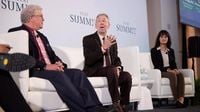On October 26, 2025, the University of Toledo will host Dr. Nina Schor, a renowned pediatric neurologist, cancer researcher, and former senior leader at the National Institutes of Health (NIH), as the featured speaker for the 16th annual S. Amjad Hussain Visiting Lecture in Medical Humanities. The event, held in the Health Education Building on the Health Science Campus, arrives at a moment of deep uncertainty for the American biomedical research community, as sweeping federal funding cuts and administrative upheaval at the NIH reverberate through institutions and laboratories nationwide.
Dr. Schor’s career embodies the intersection of medicine, science, and the arts. With a Ph.D. from Rockefeller University and an M.D. from Cornell, she has spent over three decades in academic medicine, focusing her research on neuroblastoma, a form of cancer that begins in immature nerve cells. Her journey has included leadership roles at the University of Pittsburgh, the University of Rochester, and nearly eight years at the NIH, where she most recently served as deputy director for intramural research, overseeing a vast internal research enterprise. In the fall of 2025, she returned to Rochester as professor of pediatrics, neurology, and neurobiology, and chair emerita of the Department of Pediatrics.
But Dr. Schor is not just a scientist—she is also a published poet, with works featured in the medical journal Neurology. For her, the worlds of art and science are not separate, but deeply intertwined. “I think that art and science are part of one very beautiful continuum. Each brings a richness to the other that all of us really benefit from,” she explained, as reported by the University of Toledo. Her upcoming lecture will explore how embracing the humanities can help physicians combat burnout and foster more effective, empathetic communication with patients—skills she believes are more vital than ever in the current climate.
“The subject of my talk is going to focus primarily on how one can use the writing of poetry as a personal outlet but also so one can facilitate difficult conversations with patients and families,” Dr. Schor said. She describes writing—especially poetry—as a much-needed “pop-off valve” for the intense pressures facing today’s clinicians and researchers. “Physicians and researchers are increasingly experiencing burnout for a whole slew of reasons. You’re almost like a capacitor storing up that intensity all week long. Somehow that has to discharge somewhere. How much better that it discharges in an artful form rather than anger or desperation? That pop-off valve is a very important one.”
The urgency of Dr. Schor’s message resonates even more powerfully against the backdrop of recent events at the NIH. Just days before her lecture, a panel of former NIH leaders gathered at the STAT Summit in Boston to discuss what Jeremy Berg, former director of the National Institute of General Medical Sciences, called “constant chaos” within the agency. Berg, donning a red tie patterned with a word cloud from the applications of nearly 200 junior scientists, highlighted the abrupt elimination of the MOSAIC program—an initiative that provided seed funding to early-career researchers. The program’s demise, he said, was a direct result of the Trump administration’s decision to deprioritize and cut funding for research associated with diversity, equity, and inclusion.
“It’s been like living in a washing machine, it’s been constant chaos,” Berg told the audience, according to STAT. The turbulence, he and other panelists warned, is far from over. Eric Green, who retired in March 2025 as director of the National Human Genome Research Institute, noted that about half of the NIH’s 27 institutes and centers currently have only acting administrators, making it nearly impossible to chart a path toward recovery. “I get asked this constantly: When will we start rebuilding? I don’t think we can know until we know the full extent of the destruction. There’s no reason to think we’ve bottomed out,” Green cautioned.
The impact of these changes is already being felt across the research landscape. Although the NIH managed to spend its entire $47 billion budget for the 2025 fiscal year, the number of grants awarded has plummeted. Health disparities research has withered, vaccine development efforts have slowed, and political appointees have created new obstacles for funding disbursement. Communication with current NIH Director Jay Bhattacharya has proven difficult for many in the scientific community. “I’m less convinced that he’s receptive to rational conversations,” Berg said, referencing a dismissive response he received from Bhattacharya regarding grant spending concerns.
In response to criticism, Department of Health and Human Services press secretary Emily Hilliard defended the agency’s new direction, telling STAT: “Dr. Bhattacharya is restoring the agency to its tradition of gold-standard, evidence-based science. For too long, resources have drifted toward projects with limited relevance to the health challenges facing Americans. As part of our mission to Make America Healthy Again, NIH is reviewing funded research to ensure taxpayer dollars target chronic disease and deliver measurable public health impact.”
But many in the research community remain unconvinced. Mallory Harris, senior data analyst at the Science & Community Impacts Mapping Project, described how the cuts are already creating a “lost generation” of researchers. “In the coming years, people are going to decide not to come to the U.S. very quickly. Our workforce is going to shrink and we’re going to be losing people who could have been the next Nobel Prize winners,” Harris said. Her team’s analysis found that $11 billion and 49,000 jobs have already been lost due to cuts in federal health research, with projections rising to $17 billion and 72,000 jobs lost annually if current trends continue.
The consequences extend beyond economics. The panelists at the STAT Summit expressed deep concern about the long-term effects on vaccine research and pandemic preparedness. Harris pointed to Bhattacharya’s own research on the lives saved by early vaccine deployment during flu pandemics, warning, “We just cut mRNA vaccine research, which we know gives us — we were able to turn around a vaccine in, what, 200 days? So what does that mean for the next pandemic, which will happen?”
For Dr. Schor, these developments underscore the importance of her message: that science is an inherently social and human endeavor, and that the arts—far from being a luxury—are essential to the resilience and empathy of those who advance medical knowledge. “Being a physician involves not only understanding the science and the medicine but being able to relate to and explain things to other people whose backgrounds may be very, very different from your own,” she observed. “Research also is an intrinsically social enterprise. Without discussion and exchange and consensus-building, there can be no research.”
The S. Amjad Hussain Visiting Lecture in Medical Humanities, created in honor of Dr. Hussain—professor emeritus of cardiovascular surgery and humanities, former UToledo Board of Trustees member, and columnist for The Blade—has always sought to celebrate this spirit of connection. This year, as the research community grapples with unprecedented challenges, Dr. Schor’s lecture promises to offer not just reflection, but hope for a more humane and sustainable future in medicine and science.
As the lecture approaches, registration remains open and free to the public, with RSVPs requested by October 20. For those who care about the future of science, medicine, and the role of the humanities in both, Dr. Schor’s words may offer a timely and much-needed balm.




